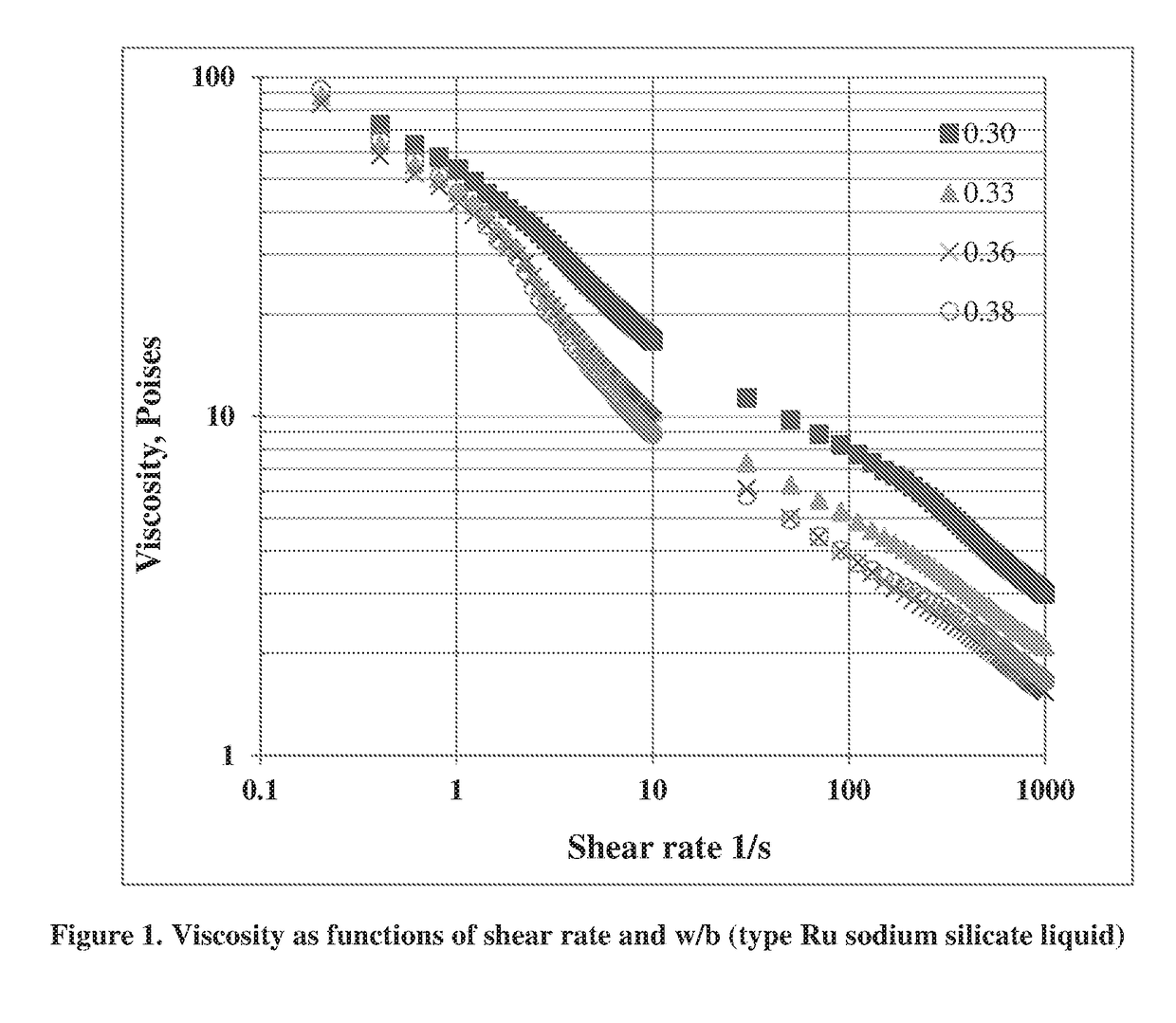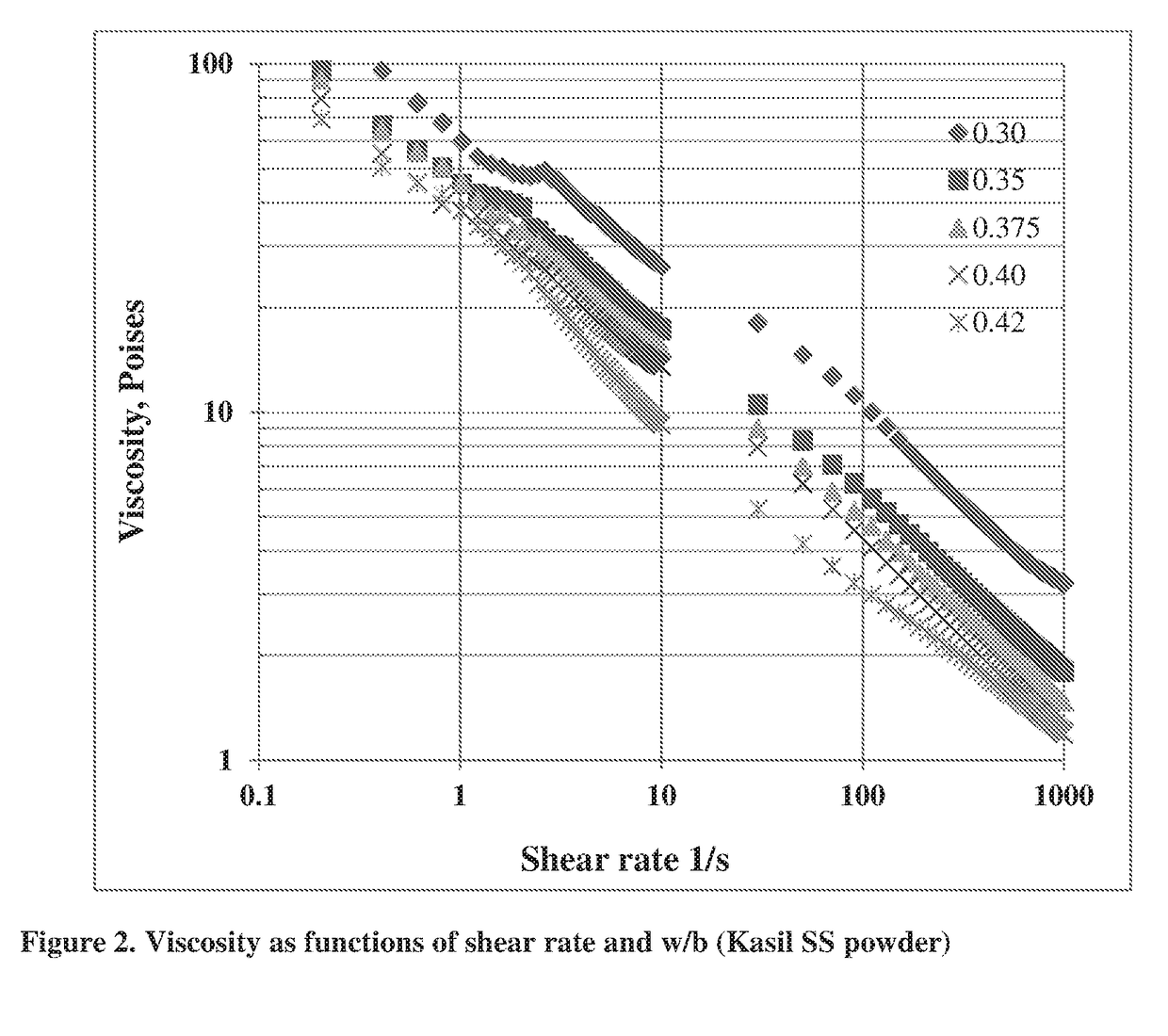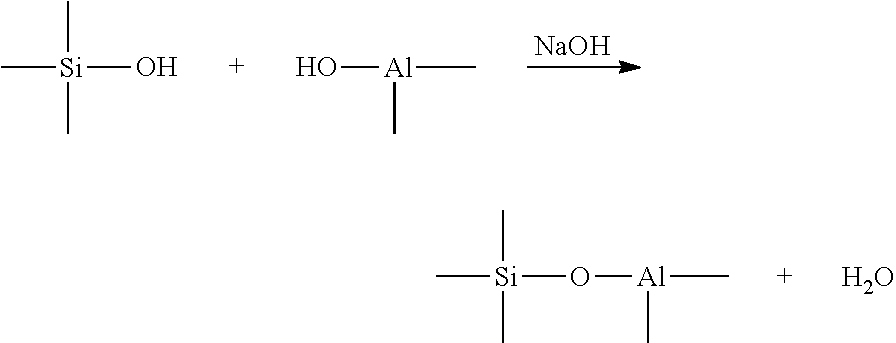Pumpable geopolymer composition for well sealing applications
a geopolymer composition and well sealing technology, applied in the direction of sealing/packing, well accessories, sustainable waste treatment, etc., can solve the problems of contaminating groundwater, affecting oil or gas production, and significant shrinkage of hardened materials
- Summary
- Abstract
- Description
- Claims
- Application Information
AI Technical Summary
Benefits of technology
Problems solved by technology
Method used
Image
Examples
example 1
[0082]To make the alkaline activator solution, NaOH flake (99 wt % assay) was added to the tap water to dissolve and then combined with Ru TM sodium silicate solution (PQ Incorporation). The activator solution was prepared such that it contains the required amounts of Na2O, SiO2 and H2O to meet the respective target w / b, molar MOH (M=Kor Na), and molar ratio of SiO2 / M2O (M=K, Na) shown in Table 1. The molar ratio of SiO2 / M2O was about 0.75. w / b was 0.40 and molar NaOH was 5. The activator was mixed with the Orlando fly ash in a Waring 7-QT planetary mixer for 4 minutes at an intermediate speed. No BFS was added. The slurry was poured into 2″×4″ cylindrical samples and vibrated on a vibration table for 3 minutes. Additionally, about five 100 ml cups were filled with the paste in order to estimate the available pumping time or fluid phase time. One sample was also prepared for set time estimation. All these samples were properly sealed, placed in a water-filled container and moved to ...
example 2
[0083]FFA from Navajo Power Station, Arizona, USA was use as the single binder in Example 2. The activator solution was prepared such that it contains the required amounts of Na2O, SiO2 and H2O to meet w / b of 0.28, a molar NaOH of 5 and a molar ratio of SiO2 / Na2O of 0.25 (Table 1). In the case of a sodium silicate solution, the molar ratio of SiO2 / Na2O is very close to the value for its mass ratio. The procedure for the sample preparation was the same as in Example 1. However, a low dosage of retarder BC (0.5% BWOB) was used. The retarder was dissolved in tap water, and then the solution was mixed with the sodium silicate solution 30 minutes before preparing the sample. Both available pumping and the set times were greater than 7 hours. The compressive strength was 423 psi after curing for 3 days and 1795 psi after curing for 28 days.
example 3
[0084]FFA from Navajo Power Station, Arizona, USA was use as a single binder in Example 3. The activator solution was prepared such that it contains the required amounts of Na2O, SiO2 and H2O to meet w / b of 0.30, a molar NaOH of 5 and a molar ratio of SiO2 / Na2O of 0.25 (Table 1). The procedure for the sample preparation was the same as in Example 1. No retarder was used. The available pumping time was greater than 7 hours and the set time was close to 24 hours. The compressive strength after curing for 48 hours was only 90 psi. However, the compressive strength increased to 2117 psi after curing for 28 days.
[0085]Examples 4 to 9 demonstrate that use of a more reactive aluminosilicate binder in addition to the less reactive FFA to achieve desirable properties when a large w / b is used.
PUM
| Property | Measurement | Unit |
|---|---|---|
| Temperature | aaaaa | aaaaa |
| Fraction | aaaaa | aaaaa |
| Fraction | aaaaa | aaaaa |
Abstract
Description
Claims
Application Information
 Login to View More
Login to View More - R&D
- Intellectual Property
- Life Sciences
- Materials
- Tech Scout
- Unparalleled Data Quality
- Higher Quality Content
- 60% Fewer Hallucinations
Browse by: Latest US Patents, China's latest patents, Technical Efficacy Thesaurus, Application Domain, Technology Topic, Popular Technical Reports.
© 2025 PatSnap. All rights reserved.Legal|Privacy policy|Modern Slavery Act Transparency Statement|Sitemap|About US| Contact US: help@patsnap.com



